Ornäs' Mandariini is an elegant chair designed by Carl-Gustaf Hiort af Ornäs in 1960. The Mandariini's special feature is its rotating, straight-line steel leg, which is combined with an almost futuristic-looking curved seat. The fabric upholstered cup seat is not only aesthetically appealing but also extremely comfortable to sit on. Practicality, durability, and beauty made the Mandariini popular in the 1960s, and the chair was sold to homes, banks, hotels and cargo ships. Today, the chair is being re-produced for the joy of all design lovers – again ready to delight in public spaces and private homes! Like other Ornäs furniture, the Mandariini chair is handcrafted in Finland.
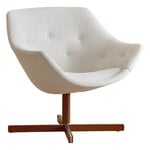
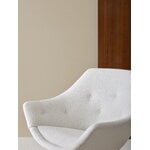

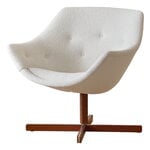
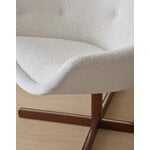
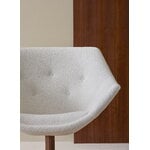
Mandariini chair, chestnut oak - offwhite Orsetto 011
Ornäs
Description
Ornäs' Mandariini is an elegant chair designed by Carl-Gustaf Hiort af Ornäs in 1960. The Mandariini's special feature is its rotating, straight-line steel leg, which is combined with an almost futuristic-looking curved seat. The fabric upholstered cup seat is not only aesthetically appealing but also extremely comfortable to sit on. Practicality, durability, and beauty made the Mandariini popular in the 1960s, and the chair was sold to homes, banks, hotels and cargo ships. Today, the chair is being re-produced for the joy of all design lovers – again ready to delight in public spaces and private homes! Like other Ornäs furniture, the Mandariini chair is handcrafted in Finland.
Product details (15)
- Colour
- Chestnut, off-white
- Width
- 77 cm
- Depth
- 70 cm
- Height
- 74 cm
- Seat depth
- 46 cm
- Seat height
- 40 cm
- Seat cushion
- Foam
- Upholstery fabric
- Lauritzon's Orsetto 011: 34 % viscose, 33 % polyacryle, 17 5 wool, 8 % polyester, 4 % linen, 4 % cotton
- Abrasion resistance
- 50 000 Martindale
- Pilling
- 4
- Lightfastness
- 4-5
- Base material
- Stained oak in chestnut shade, metal
- Weight
- 30 kg
- Removable cover
- No
- Care instructions
- Wipe wooden parts with a damp cloth. For upholstered parts vacuum them regularly using a clean upholstery attachment.
- Product ID
Designer
Carl-Gustaf Vilhelm ”Nalle” Hiort af Ornäs (1911–1996) was a Finnish interior architect and designer, whose most famous design is the Siesta armchair from 1952. In 1945 Hiort af Ornäs founded the furniture company Puunveisto Oy, for which he developed versatile techniques for shaping plywood. Hiort af Ornäs spent his retirement in Spain, and designed several buildings for Fuengirola’s Los Pacos neighbourhood, which has a large Finnish population.
View all productsReviews (0)
Sustainability
The Product Sustainability Framework, our criteria of sustainable design, helps you find the most sustainable products in our selection. Read below which sustainability criteria this product has met.
Working conditions & labour 4/9
-
Equal opportunities for all employees
-
Commitment to UN Global Compact, fair compensation for all employees
-
Corporate responsibility requirements defined and communicated for suppliers
-
Systematic work for improved inclusion and well-being in the workplace
-
Transparent supply chain
-
Suppliers' compliance to a code of conduct ensured
-
Direct suppliers audited and certified
-
Compliance to the UN Guiding Principles on Business and Human Rights ensured in the supply chain
-
Support for community involvement in the supply chain
Eco-friendly production 6/9
-
Fair and resource-wise water-use in production
-
No incineration or landfilling of returned items
-
No use of endangered species as materials
-
No direct environmental emissions or waste (excl. GHGs) from production
-
Material-efficient and ecological packaging
-
No potentially harmful chemicals used in own production
-
The sustainability of direct suppliers' production is addressed and monitored
-
Production and material sourcing that respect biodiversity, animal rights, and natural ecosystems
-
Positive impact on nature’s well-being through operations that regenerate natural ecosystems
Climate impact 4/8
-
Company's direct greenhouse gas emissions identified and commitment to reduction
-
Product's carbon impact identified and commitment to reduction
-
Guidance on energy- and eco-efficient use of the product
-
100 % renewable energy in own production and operations
-
Contribution to climate initiatives beyond the brand’s direct operations
-
Low-carbon or compensated transportation
-
Carbon footprint of the product calculated and goals set to reduce it
-
Carbon neutral or carbon negative product
Sustainable materials 5/6
-
Sustainable and long-lasting material choices
-
No harmful or hazardous substances
-
Responsible raw material sourcing and production
-
Materials suited for circularity: monomaterials, recyclable finishings, renewable or recycled contents etc.
-
Ecological materials: natural, biodegradable, recyclable or recycled contents
-
Outstanding materials in terms of innovativeness, responsibility, sustainability and circularity: local production or sourcing, 100 % recycled content, C2C-certification etc.
Circular design 5/5
-
High aesthetic quality promoting long-term use of the product
-
Technically durable product design and material choices
-
Design for enduring life-long quality
-
Design and support for product maintenance, repair and upgradability
-
Innovative circular design solutions: circular service system, resale platform, remanufacturing, collection of used products, etc.







